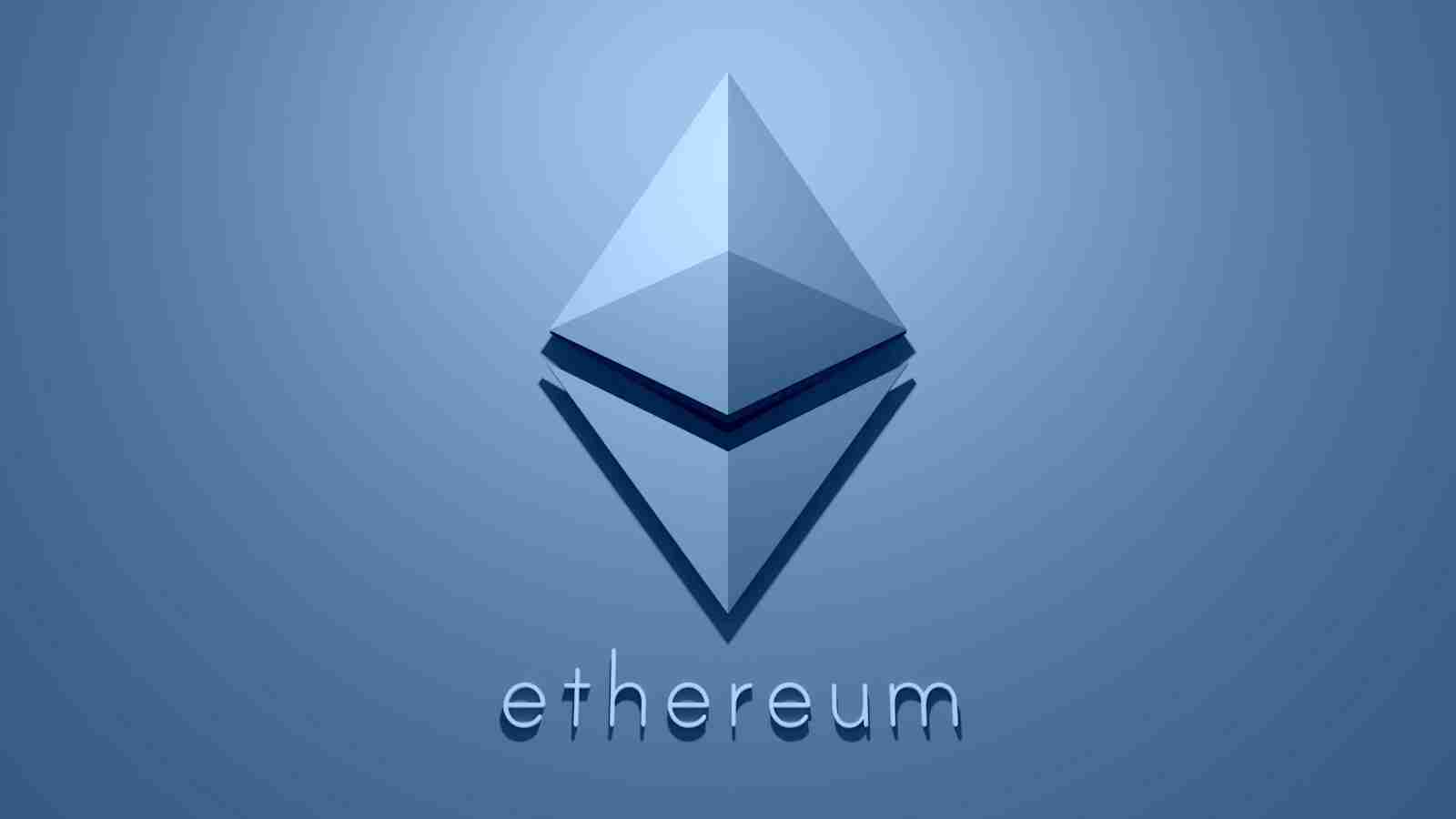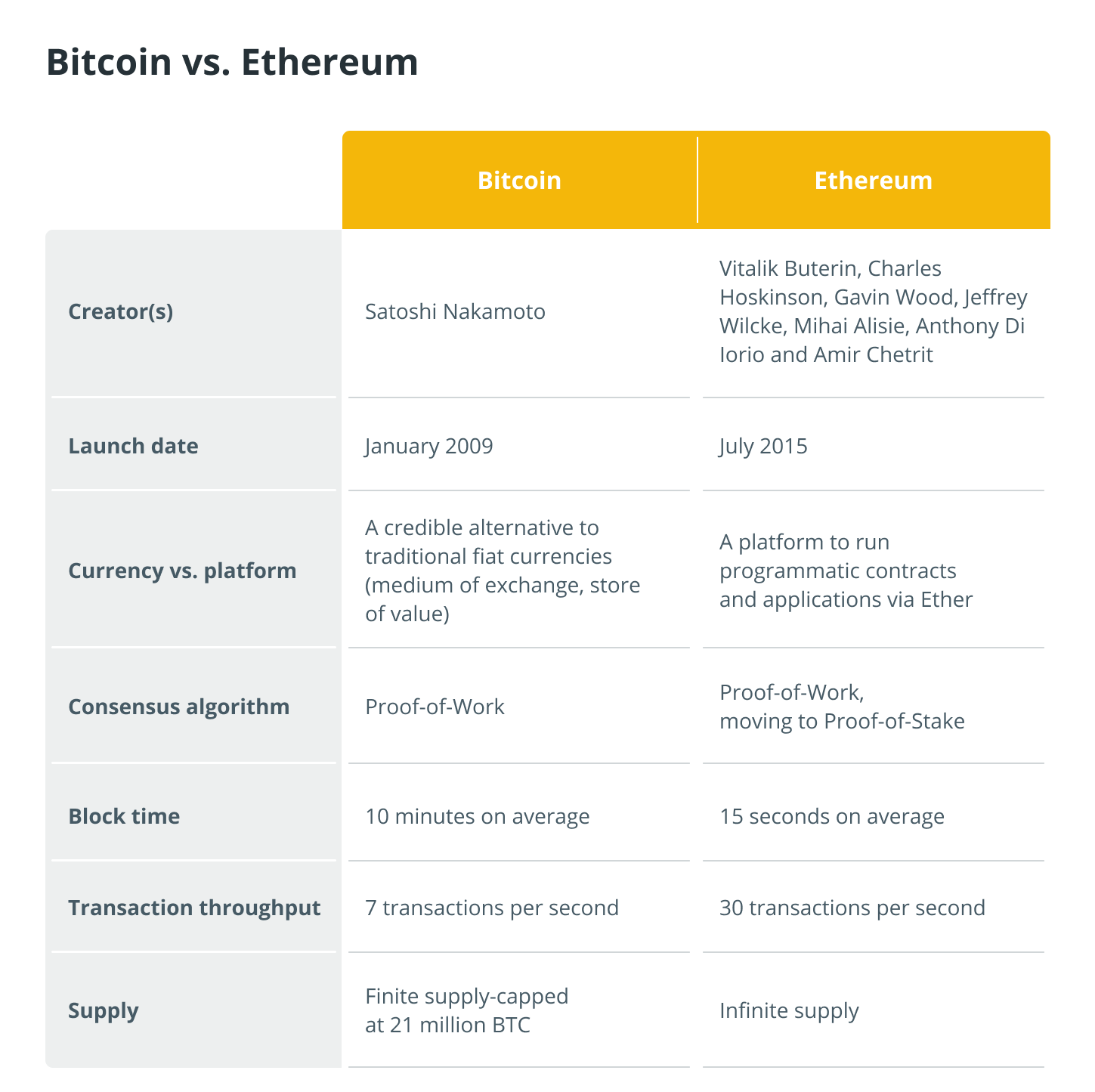Bitcoin (BTC) and Ethereum (ETH) are arguably the two cryptocurrencies that have the most market share currently and have made significant contributions to the expansion of the sector.
Bitcoin was the first ever cryptocurrency ever to be successfully created, and it is often referred to as digital gold or “gold 2.0.” Ethereum, on the other hand, can be thought of as a decentralized computer for the entire world.
Bitcoin is often compared to gold due to its scarcity and durability, much like the precious metal; however, unlike gold, bitcoin can be easily stored and distributed.
Because its network is used to run decentralized applications (also known as DApps), Ethereum is often referred to as the world’s first truly decentralized computer. By definition, DApps are software programs that aren’t managed by a centralized authority.
Bitcoin and Ethereum come out on top when compared using a variety of metrics intended to measure cryptocurrencies.
These metrics are examples of market capitalization, the number of unique wallet addresses, and the trading volume on cryptocurrency exchanges.
The total dollar value of a cryptocurrency’s circulating supply is referred to as market capitalization, which is also abbreviated as “market cap.”
When discussing cryptocurrencies, the term “wallet address” refers to a singular string of characters that acts as a proxy for an account on a cryptocurrency’s underlying network.
Both Bitcoin and Ethereum have some things in common, including; They are assets that are based on a publicly displayed distributed ledger called a blockchain, and they can be stored in digital wallets. Addresses for these assets are strings of alphanumeric characters, and they are traded on cryptocurrency exchanges.
Both Bitcoin and Ethereum are examples of decentralized cryptocurrencies, which means that neither central banks nor any other type of financial authority can issue or regulate them.
Instead, they rely on computers that are constantly running copies of their networks. These computers are referred to as nodes, and they ensure that every participant in the network is on the same page.
Both Bitcoin and Ethereum are cryptocurrencies, but they are very different in significant ways. These distinctions set them apart from one another and have sparked a variety of debates, in which some people have argued that BTC and ETH are rivals.
In point of fact, due to the fact that they serve different purposes, they might complement one another. While Bitcoin (BTC) can be kept as an investment for the future, Ethereum (ETH) is the currency that is used to interact with applications that are built on the Ethereum blockchain.
While ETH may be used to gain access to decentralized financial (DeFi) services, Bitcoin (BTC) may be used in a portfolio to maintain value and act as a safe haven. A safe haven is an asset whose value is anticipated to either remain stable or increase when there is a downturn in the market.

What is Bitcoin (BTC)?
Bitcoin was the first cryptocurrency ever created, and it was designed from the ground up to operate decentralized from any central authority.
In January 2009, the pseudonymous person who is credited with creating Bitcoin, Satoshi Nakamoto, mined the first block of data to be added to its blockchain. This block is referred to as the genesis block.
Since that time, the number of people using Bitcoin has been gradually increasing over the course of time. Because Bitcoin was designed from the ground up to function as a peer-to-peer (P2P) electronic cash system, it enables users to conduct transactions independently of any single governing body.
In 2008, Nakamoto published a white paper in which he introduced the idea that would later inspire the development of the blockchain technology that underpins Bitcoin.
Bitcoin gives its users the ability to control their own currency, free from the oversight of any central bank, government, or other financial institution. Instead, it is dependent on a distributed network of users who are running the blockchain software for Bitcoin, which has a set of rules that every participant in the network has agreed to.
The rules determined by the software govern how transactions work, the amount of time it takes to settle, a supply limit of 21 million BTC, and other factors.
A blockchain is a form of decentralized ledger technology (DLT), and Bitcoin was the first cryptocurrency to utilize this technology.
The Byzantine Generals Problem, which describes the difficulty that decentralized systems have in agreeing on a single truth, was one of the issues that blockchain technology was able to solve.
Bitcoin uses a method called proof-of-work, also known as PoW, in conjunction with a blockchain to get around the Byzantine Generals’ Problem. The challenge can be overcome as a result of the multiple miners, each of whom plays the role of a general.
Every node in the network will make an effort to validate transactions that are the same as communications that are being sent to generals.
The blockchain that records transactions for Bitcoin is made available to the public and includes a history of each and every transaction that has ever been processed on it. Additionally, the blockchain is distributed across multiple nodes to protect it from being tampered with.
Tampering is the process by which other network participants decide whether to accept a new block that has been added to the blockchain.
Hashes are long strings of numbers that must be exactly the same for every node in order to detect tampering. These hashes are referred to as hashes.
The SHA-256 hash function is the algorithm that processes data in order to turn it into those long strings of numbers. The Bitcoin network uses this function to process sets of data and transform them into hashes.
When a hash that is known to be valid is discovered, it is added to a new block and then broadcast to the network.
Miners on the Bitcoin blockchain use a Proof of Work (PoW) process in which machines use an enormous amount of computing power to engage in hashing functions.
These blocks are then broadcast to the network after being mined. Participants in the network arrive at a decision through the use of proof-of-work.
Mining and consensus are two processes that are integral to Bitcoin and ensure that malicious users cannot change the balances of other users or spend their funds twice. Additionally, these processes ensure that the network is always operational with very little downtime.
Bitcoin’s rising popularity can be attributed, in part, to the fact that it is unhackable and transactions can be made at any time, all without the need for intermediaries or centralized banks to control the cryptocurrency.
While bitcoin was initially designed to function as a medium of exchange — that is, a currency that could be used to pay for goods and services — later on, it came to be used primarily as a form in which to store value. A valuable asset that retains its worth over the course of time is known as a “store of value.”

What is Ethereum (ETH)?
Ethereum goes one step further by utilizing blockchain technology to create a decentralized computer. While Bitcoin uses blockchain technology for monetary transactions and allows nodes and messages to be attached to each transaction, Ethereum takes this a step further by utilizing blockchain technology to create a decentralized computer.
Ether (ETH), Ethereum’s native cryptocurrency, is used to make transactions and interact with applications built on top of the Ethereum network. Ethereum is a decentralized, open-source, and distributed blockchain network.
In 2013, Ethereum’s co-founder Vitalik Buterin published a white paper detailing smart contracts‘ use. Smart contracts are agreements that can carry out their terms automatically and are written in code.
The use of smart contracts makes it possible to develop decentralized applications, also known as DApps. These are software programs that can function independently of anyone controlling the organization.
In 2014, Buterin and the other co-founders of Ethereum sold Ether in order to raise capital for the continued development of Ethereum.
Buterin, Gavin Wood, Jeffrey Wilcke, Charles Hoskinson, Mihai Alisie, Anthony Di Iorio, and Amir Chetrit are the other individuals who contributed to the creation of Ethereum.
Additionally, the co-founders established the Ethereum Foundation in Switzerland. This is a charitable organization whose sole mission is to provide support for the Ethereum network.
Launched in July 2015 as one of the most ambitious projects in the cryptocurrency space, the Ethereum network was designed to decentralize every aspect of the internet in order to realize its full potential.
Ethereum, like Bitcoin, is a decentralized platform, meaning it does not have a central authority that governs it. Instead, it relies on proof-of-work (PoW) to ensure malicious actors cannot change the data stored on the blockchain.
Solidity, Ethereum’s proprietary programming language, is the language that is utilized for the programming of smart contracts, which are then executed on the blockchain.
Because smart contracts can be used, Ethereum could have a diverse range of applications if it were developed further.
It’s possible that its primary use cases have not yet been conceptualized, much like how Facebook and Google didn’t come into existence until many years after the internet was first introduced.
The rate of innovation on the Ethereum network is rapidly increasing, with decentralized applications now offering financial services and nonfungible tokens (NFTs) serving as examples of what smart contracts enable developers to create.
Ether, on the other hand, is used to interact with applications that run on the Ethereum network. Bitcoin, on the other hand, is used as a medium of exchange and a store of value.
Users are required to pay fees in Ether in order to create smart contracts, pay for transactions, and use decentralized applications (DApps). As the price of ether continued to rise, more and more people began to keep their wealth in ether wallets.
Decentralized applications that are built on Ethereum make it possible for ether and other cryptocurrencies to be used in a wide variety of contexts, such as serving as collateral for loans or being lent out to borrowers in order to earn interest.
The term “collateral” refers to any assets that are put up as a guarantee for the repayment of a loan. For instance, a user may utilize a decentralized application to obtain a loan in the amount of $750 while simultaneously earning interest on the $1,000 worth of ETH that they initially deposited in the application.
The key differences between BTC and ETH
In spite of the fact that both the Bitcoin and Ethereum networks are founded on the idea of distributed ledgers and encryption, the technical specifications of each network are very dissimilar to one another.
Ether, on the other hand, is used to power the Ethereum network and the applications that run on it. Bitcoin, on the other hand, serves as the digital equivalent of gold and is used to store value.
On the Ethereum network as well as the Bitcoin network, it is possible to issue brand-new tokens.
The Omni layer is a platform for the creation and trading of currencies that are built on top of the Bitcoin blockchain. Bitcoin uses this platform. The adoption of the Omni layer has been focused primarily on stablecoins.
Tokens based on Ethereum, on the other hand, are issued in accordance with a variety of standards, with ERC-20 being the most widely used of these.
A set of guidelines for tokens that are used on the network are outlined in the ERC-20 standard. The ERC-20 standard stipulates that developers must incorporate a number of essential features into their tokens before they can be distributed.
These functions include disclosing information about the total supply of the token, disclosing account balances for users’ addresses, and enabling the movement of funds between addresses.
Bitcoin transactions are monetary in nature; however, notes and messages can be attached to transactions by encoding these notes or messages into data fields within the transaction. Notes and messages can also be attached to Bitcoin transactions.
Transactions on Ethereum can include code that can be executed to either create smart contracts or interact with self-executing contracts and applications that are built using them.
The length of time it takes for new data blocks to be added, which in turn determines how long it takes for transactions to be confirmed, is another area in which these networks are distinct from one another.
On the Ethereum network, new blocks are added approximately once every 15 seconds, whereas on the Bitcoin network, the average time it takes to add a block is 10 minutes.
The public wallet addresses on each network are also unique to that network. Comparable to an International Bank Account Number (IBAN), which is a unique identifier that financial institutions use to determine which bank and country an individual’s account belongs to, these wallet addresses are one-of-a-kind identifiers that make it possible for users to receive funds. Wallet addresses are used in the same way. On Bitcoin, addresses can begin with either a 1 or a 3, or they can begin with “bc1,” whereas on Ethereum, addresses begin with “0x.”

While Bitcoin and Ethereum have historically reached consensus through the use of proof-of-work, Ethereum is currently transitioning away from this method in favor of a proof-of-stake consensus algorithm.
The proof-of-stake protocol bases its operations on the amount of network stake held by a transaction validator.
Users are required to stake their ETH in order to become validators on Ethereum. Validators are entities that verify transactions to ensure that the Ethereum network is not being tampered with in any way.
By attributing mining power to the proportion of validators’ tokens rather than requiring miners to use specialized computers, proof-of-stake consensus algorithms reduce the amount of energy that is required to reach a consensus.
Because it is easier to become a validator in a proof-of-stake network, this type of network uses less energy, has lower barriers to entry for potential validators, and has greater resistance to decentralization.
ERC-20 tokens, which are a form of Bitcoin’s representation, can also be found on the Ethereum blockchain.
A tokenized version of Bitcoin was developed and distributed on Ethereum so that users could take advantage of decentralized applications.
On the Ethereum network, numerous tokenized versions of bitcoin are currently in circulation.
Bitcoin backs these at a ratio of 1:1, which means that for every ERC-20 token that represents Bitcoin that is out in circulation, there is one BTC that is being held as collateral for it.
Users are able to continue holding Bitcoin (BTC) while using decentralized applications thanks to tokenized versions of Bitcoin that run on Ethereum. Token holders, for instance, have the ability to lend out their Bitcoin in exchange for interest.
Bitcoin vs. Ethereum: scaling solutions
The bottom Both the Bitcoin and Ethereum networks have problems with their ability to scale. In comparison, the Ethereum network is capable of processing approximately 30 transactions per second, while Bitcoin can only handle an average of seven transactions per second.
Visa, on the other hand, processes approximately 1,700 transactions every second while claiming to have the capacity to scale up to 24,000.
Both Bitcoin and Ethereum are close to reaching their capacity limits and are in need of solutions that will assist them in accommodating a greater number of users. This is because the number of people using both blockchains has been steadily increasing over time.
As things stand, transaction fees on both networks go up whenever there is a greater demand for block space than they are able to satisfy.
Bitcoin and Ethereum each take a unique approach to the problem of scaling their respective networks.
Bitcoin has “segregated” some data outside of the space available in each block that is propagated to the network thanks to an upgrade called Segregated Witness (SegWit), one of the technical improvements implemented.
SegWit enables more effective utilization of the meagre 1 MB of storage space each Bitcoin block possesses.
Additionally, developers have been working on a layer-two scaling solution, which refers to a solution that would build a transaction layer on top of the base blockchain. This solution is known as the Lightning Network.
Because users create their own payment channels, transactions on the Lightning Network are processed very quickly, and the fees associated with them are extremely low.
The user-generated payment channels of the Lightning Network are already pre-funded with BTC, and this feature may make it possible for the majority of transactions to be moved off of the main blockchain and into the layer-two network.
The Lightning Network is anticipated to have the capacity to process up to 15 million transactions per second its proponents.
Because the only transactions that would be settled on the base Bitcoin blockchain would be those involving the opening and closing of Lightning Network payment channels, these would not be settled on the Bitcoin network itself.
Additionally, scaling solutions are being implemented for Ethereum that will be able to function both on the core Ethereum network and through layer-two networks.
Sharding is the primary strategy that Ethereum is betting on to expand its base blockchain. Sharding would reduce network congestion and increase the number of transactions that can take place per second by creating new blockchains that are referred to as “shards.”
Because of the potential for shard chains to help distribute the necessary computing resources for Ethereum’s operation across a total of 64 networks, the requirements for the amount of Random-Access Memory (RAM) and storage space on each device that runs the Ethereum blockchain would be significantly reduced.
There is a significant amount of variation between implementations with regard to the manner in which these transactions are grouped and then broadcast to Ethereum. Sidechains are a term used to refer to alternative solutions for Ethereum’s layer two problems.
Sidechains are autonomous networks that operate in parallel with the Ethereum network. They are compatible with the Ethereum network thanks to protocols that enable users to transfer tokens from one network to another. This effectively enables users to use applications that are built on ETH while incurring lower transaction fees.
Both Bitcoin and Ethereum make use of a number of different scaling solutions, which help to reduce the amount of congestion on the network and increase the number of transactions that can be processed in one second.








